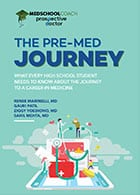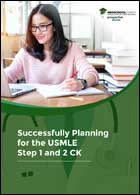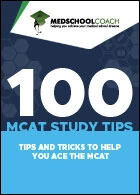
Table of Contents
Knowing what to expect on the day of your MCAT (Medical College Admission Test) is key to feeling confident and achieving your highest score. You want to show up completely prepared — taking the MCAT is one of the most important events of your premed career.
In this MCAT test day guide, I’ll walk you through everything you need to know, from what to bring, to the full exam schedule, and 10 tips for success.
The proof is in the numbers. Students who utilize 20+ hours of tutoring with MedSchoolCoach see an average MCAT score increase of 12 points.
Rules to Know for Test Day
To ensure a smooth and successful experience, familiarize yourself with the testing conditions and guidelines set by the Association of American Medical Colleges (AAMC). Studying and test prep is hard enough, and dealing with logistical issues on exam day is an avoidable stressor.
Here are the MCAT essentials you need to know for test day:
1. Valid Identification Is a Must
On the day of your MCAT exam, you’ll present the test administrators with a valid government-issued photo identification like a driver’s license or passport. Expired IDs aren’t permitted, so make sure you get a new ID if yours will expire before test day.
Your ID must match the information you provided during your MCAT registration. You can’t take the test if the names don’t match. If you’ve recently changed your legal name, double-check in advance that your government ID matches the name you used in the MCAT registration system.
2. Your Hands Will be Scanned and Your Photo Taken
As an additional security measure, you will have your palms digitally scanned, and a test-day photograph will be taken. While this might feel like a bit much, it’s one way the AAMC prevents identity fraud and protects the integrity of the testing process.
3. Only Specific Items Are Allowed in the Testing Room
These typically include your valid ID, your MCAT registration printout, and any necessary medications you have to take while at the testing center. (Scroll to the next section for a full list of what you can and can’t bring.)
4. Certain Items Are Only Accessible During Breaks
During the actual test, there are designated breaks during which you can access snacks, drinks, and any essential medications. However, electronic devices, study materials, and any unauthorized items are strictly prohibited throughout the day.
The AAMC recommends leaving electronic devices and study materials in your car, as touching electronics (even if you don’t use them to look up MCAT-related information) is a violation of MCAT policies.
With MCAT GO, you can prepare for the MCAT with an audio-learning experience curated by MedSchoolCoach experts. Study on the Go. Anytime, Anywhere.
5. You’ll Get Noteboard Booklets for Notes
You will be provided with noteboard booklets and fine-point markers for note-taking during the exam. These noteboard booklets are for rough work, calculations, and jotting down ideas. You cannot bring any personal scratch paper into the testing room.
Items to Bring (And What to Leave at Home)
The AAMC is very particular about what you can bring into the testing center and testing room, and what should be left in your car or at home. Violate their policies, and you may find yourself unable to apply for med school this cycle.
Here’s what’s allowed and what’s not:
Items You May Store in Your Locker for Access During Breaks
- Food and/or drink: You can bring snacks and beverages, such as water or a sports drink.
- Medicine: If you require any prescription or over-the-counter medications, you’re allowed to bring them.
- Personal hygiene items: Personal hygiene items like tissues or hand sanitizer are permitted.
- Eyeglasses: You can bring your glasses and wear them during the entire exam; however, test administrators are allowed to examine them if they are concerned about compliance.
Items You May NOT Bring to the Testing Center
- Notes, test prep pages, and review books: Any external study materials, notes, or review books are strictly prohibited inside the test center.
- Electronics (tablets, laptops, smart watches, etc.): Holding or touching electronic devices like tablets and laptops (including calculators) is a major MCAT violation (even if you’re just checking your email). Leave all electronics at home.
- Earbuds or headphones: While you may prefer to study or test with headphones, they are not allowed during the exam. The test center will provide any necessary noise-canceling headphones if needed.
- Visitors: You are not allowed to bring anyone with you to the testing center.
Items You May Bring But NOT Access on Any Break
- Cell phone: You can bring your cell phone to the testing center, but it must be sealed in the bag provided by the test center staff. You won’t have access to your phone during the exam, but it can be safely stored in your locker if you’re uncomfortable leaving it in your car. Under no circumstances are you allowed to touch your phone until after the exam is finished. The test center administrator has to physically remove your phone from its bag.
- Backpack or purse: Your bags or backpacks must remain in your locker during the exam and breaks. You’re permitted to grab food, drinks, or medications from your bag but the bag itself can’t leave your locker.
- Vehicles: You cannot leave the test center premises during breaks, and that includes walking to or accessing your vehicle.
Ace your exam with MCAT practice tests from MedSchoolCoach. Ours are the most representative practice exams available, designed to replicate the real-life test as much as possible.
What to Expect: The Schedule
MCAT test day follows a structured schedule to ensure a fair and standardized testing experience for all examinees. Here’s what to expect throughout the day:
Arrival and Check-In
Arrive at the test center at least 30 minutes before your scheduled start time. Plan for potential traffic or unexpected delays. Upon arrival, you’ll go through a check-in process, which includes verifying your identity, having your palms digitally scanned, and taking a test-day photograph.
Exam Sections and Breaks
The MCAT exam consists of 4 sections, each with a specific duration and purpose. These 4 sections include:
- Chemical and Physical Foundations of Biological Systems (95 minutes)
- Critical Analysis and Reasoning Skills (CARS) (90 minutes)
- Biological and Biochemical Foundations of Living Systems (95 minutes)
- Psychological, Social, and Biological Foundations of Behavior (95 minutes)
The MCAT Prep App is engaging, fun, and a fraction of the price of traditional test prep! Access our expert-made videos, flashcards, and question bank from your phone.
There are designated 10-minute breaks between testing sections. These brief intervals allow enough time to stretch, hydrate, and briefly recharge. You can access your stored snacks and beverages during these MCAT breaks to maintain your energy.
After completing the first two sections, you’ll have a longer 30-minute lunch break. During this mid-exam break, you can access your stored food and drink and relax.
Owen Ezell took the MCAT in 2020 and scored a 522. Here’s his take about food and beverages on the day you take the MCAT:
"Your food has to be locker-friendly. There's no refrigerator to store stuff. It’s probably not a good idea to eat a full meal at any point during the MCAT because it might tank your energy level. And be careful about overloading on caffeine — it may seriously hurt you, rather than help. My recommendation is that students stick to their normal caffeine routine during test day. The MCAT is not the time for a caffeine cleanse, and it's also not a good idea to chug a thermos of coffee if you're not used to it. Students should consume exactly the amount of caffeine they need to maximize their focus."
Owen Ezell, 522 MCAT Scorer
Manage your time wisely during lunch to ensure you return to the testing room promptly. Administrators are consistently reminding students when break time is over, so you’ll get ample instructions and reminders so you don’t enter the testing room late.
Leaving and Re-Entering the Exam Room
When you leave the exam room for a break, you’ll need to follow the instructions of the test center staff. Upon re-entering, you’ll go through a check-in process again to ensure the security of the exam environment.
Bathroom Breaks
Bathroom breaks are allowed during the exam, but they must be taken during designated break times. You won’t lose testing time for bathroom breaks taken within these intervals.
If you need to use the restroom outside of designated breaks, you’ll need to follow the test center’s procedures and be accompanied by a staff member.
If you have a disability or medical condition that you believe makes it difficult for you to take the test under standard conditions, you’ll need to apply in advance for MCAT accommodations. It’s not guaranteed that your requests will be accepted, but the AAMC does make concessions for certain circumstances with appropriate medical documentation.
10 Tips for MCAT Test Day Success
To help you excel, I’ve compiled 10 MCAT tips based on insights from experienced test-takers and our team of experts:
1. Arrive Early and Prepared
Arrive at least 30 minutes early to the test center on your exam date. Nothing feels worse than getting there late because of traffic you didn’t expect, or not entering the testing room on time because you had an ID problem.
I like to recommend students carry a folder with their registration confirmation and ID so they can bring it inside and not spend time rifling through a backpack or wallet upon arrival.
2. Familiarize Yourself With the Test Center
Knowing the layout of the test center building in advance can reduce stress and eliminate some of the worry of “how will I know where to go?!”. Before your exam date, pay a quick visit to the building that houses the test center, just to ensure you know where you’re going.
3. Dress Comfortably in Layers
Dress in comfortable, layered clothing appropriate for varying room temperatures. You want to stay focused on the exam, not on discomfort.
4. Bring Snacks and Hydrate
Pack snacks and beverages to keep your energy levels stable during breaks. Staying hydrated is essential for optimal brain function. And resist the urge to eat a full meal — avoid getting hungry, but remember that too much food can make you want to take a nap (and ignore one of the most important tests of your educational career).
5. Manage Test Anxiety
Test anxiety is common. Practice relaxation techniques, such as deep breathing, to stay calm during the exam.
6. Time Management
Allocate your time efficiently for each section to ensure you complete all questions. Don’t linger too long on any single question — if you get stuck, move on and come back later if you have time.
To do this, use the “flag” feature. The MCAT lets you flag questions that you’re unsure about so you can go back to them if you have time at the end of the section.
7. Stay Positive and Stay on Track
Maintain a positive mindset, even if you encounter challenging questions. Don’t let one difficult question disrupt your overall performance, as MCAT scores are scaled to reflect the fact that certain sections are more difficult on specific test days.
Ezell had to contend with a tendency to panic during his exam. Here was how he managed the emotions:
“There will be times during the exam when the questions feel super hard and you feel like you're bombing it. The key is to not panic — the AAMC actually creates sections with different difficulties. Some days, the Chem/Phys section will be easy (the average test taker gets more questions right), and some days, it will be super hard (the average test taker gets more questions wrong). There's a good chance that if you're struggling with a certain section, everyone else who got that version of the test is also struggling. And in that case, the AAMC will adjust everyone's scores up so they equate to scores from days when the section/exam was easier. You can't judge what your score will be based on how many questions you think you're getting wrong. If it's an especially hard version of the test, you may score higher than you think. I did!”
Owen Ezell
8. Don’t Over-Caffeinate
Many students think that an energy drink or quad espresso will help them stay alert and able to recall information. However, don’t consume more caffeine than you normally would — over-caffeinating may lead to jitters and an inability to stay focused on the exam in front of you.
9. Review Your Work
If time permits, review your answers. Even a quick review can make a difference. And be sure to pay special attention to any questions that you flagged as difficult along the way. You want to focus your review time on questions you’re unsure about, not on those you’re confident in.
There’s also a screen at the end of each section that indicates if you left any questions blank. Give it a quick glance to ensure you didn’t accidentally skip anything. Remember — there’s no penalty for guessing, so you want to ensure that every question has an answer!
10. Follow Test Center Rules
Adhere to test center rules and guidelines at all times. This includes respecting the designated break times and not exceeding them, not attempting to go to your car for any reason, and following rules about electronics.
Read Next: When Should You Take the MCAT?
FAQs
Yes, you can bring beverages, such as water, coffee, or a sports drink, to the testing center and access them during designated breaks to stay hydrated.
Dress comfortably in layers, as testing room temperatures can vary. Choose clothing that allows you to adapt to different conditions.
Yes, you can bring your earplugs; however, the test center will provide noise-canceling headphones if needed.
The MCAT exam typically takes approximately 7.5 hours, including breaks and the lunch break.
Your total MCAT score is a sum of your scores in each of the 4 sections. Each section is scored from 118 to 132 based on the number of questions you answer correctly (scaled to the relative difficulty of your version of the exam), with no penalty for incorrect answers.
These scaled scores (between 118-132 per section) are combined to provide your official score in the final 472-528 range.
You can take the MCAT up to 3 times in a single testing year, 4 times in 2 years, and 7 times in a lifetime. It’s important to schedule your test dates strategically to maximize your chances of success.
Don’t Leave Your MCAT to Chance: Work with a 99th Percentile Tutor
It’s possible to walk confidently into your MCAT test day. Proper preparation, including structured study plans, practice exams, and expert guidance from our tutors, has resulted in consistently high MCAT scores for students who work with MedSchoolCoach for tutoring.
Our MCAT Tutors are 520+ scorers who have extensive MCAT and teaching experience. Speak with a member of our team today to learn how we can help you ace your exam.

Ken Tao, PhD
Ken is the Director of MCAT and Research at MedSchoolCoach. He is an alumnus of UC Berkeley and Harvard University, boasts degrees in Bioengineering, Molecular and Cell Biology, and a Ph.D. in Neuroscience. Ken previously worked with undergraduate students at Princeton Review where he was the only tutor certified in all subjects. Ken was one of the highest rated MCAT tutors ever and a teacher trainer. He founded Magoosh's MCAT division and has written content for dozen's of MCAT books and guides.





